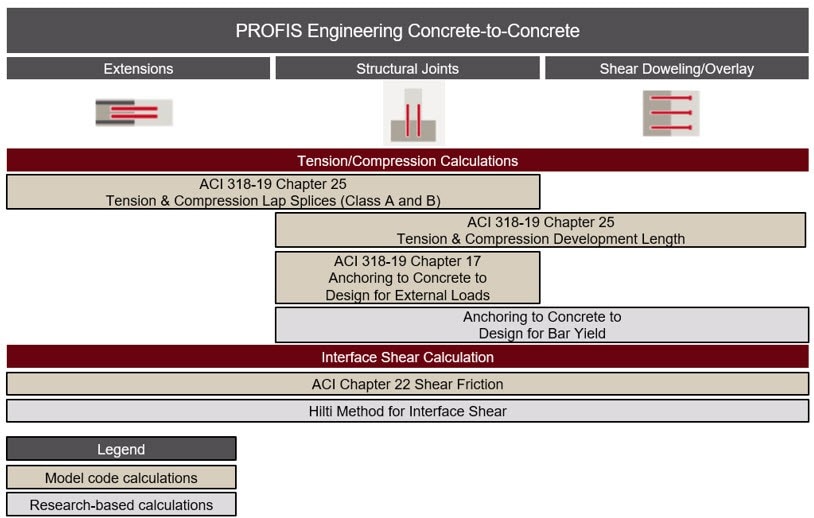

Achieve faster post-installed rebar design with PROFIS Engineering. Design post installed rebar for slab/wall extensions, structural joints, or concrete overlays using a variety of methods including ACI 318 development length, lap splices, shear friction, and anchoring to concrete
provisions.
With multiple design options, switching between design resources can be cumbersome and time consuming. PROFIS Engineering’s newest concrete-to-concrete design module brings together model code compliant design methods with new alternative research-based design methods to help simplify post-installed rebar designs.
Watch an Introduction the PROFIS Engineering Concrete-to-Concrete module here
Various design methods are included in the PROFIS Engineering Concrete-to-Concrete module
All PROFIS Engineering users can take advantage of cloud-based file storage, automatic software updates, and favorites tab.
PROFIS Engineering premium users can save time by running multiple load combinations, importing loads from excel, saving design templates, report templates, and project folder sharing capabilities.
Get started today with the new PROFIS Engineering Concrete-to-Concrete module
profisengineering.hilti.com
The Concrete-to-Concrete module has three connection types available for design
Extensions
The extensions selection is for connections where post installed rebar will splice with existing rebar.
The software provides the tension or compression lap splice length, depending on the user defined loads. When a shear load is applied, the shear friction calculations will be provided. The software also enables more design flexibiltiy, allowing users to select the research-based alternative for an interface shear calculation called the Hilti Method for Interface Shear.
Structural Joints
The most comprehensive connection selection with all the design options available.
Easily switch between the various options for post installed rebar design including model code based option of development length, lap splices, and anchoring to concrete. The software provides two ways of using the anchoring to concrete provisions, one is based on the model code and one is research-based. Anchoring to Concrete to Design for External Loads compares the design capacities to each of steel, concrete breakout, and bond strengths based on ACI 318/CSA A23.3. The Anchoring to Concrete to Design for Bar Yield is an alternative design option which compares the concrete breakout and bond strength equations to nominal yield strength of the steel.
For the interface shear calculations, users have the design flexibility of using the ACI shear friction calculation or a research-based option called the Hilti Method for Interface Shear.
Shear doweling/Concrete overlay
When thickening or extending a wall or slab, design for interface shear with model code compliant and researched-based options.
For an overview of the all the design options and installation requirements, refer to the Post Installed Reinforcing Bar Guide here.

